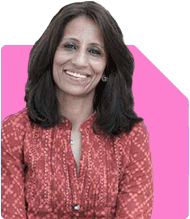Anu Krishna |1746 Answers |Ask -Follow
Relationships Expert, Mind Coach - Answered on May 19, 2023
The co-founder of Unfear Changemakers LLP, she has received her neuro linguistic programming training from National Federation of NeuroLinguistic Programming, USA, and her energy work specialisation from the Institute for Inner Studies, Manila.
She is an executive member of the Indian Association of Adolescent Health.... more

Hello ma'am..i am 44 years married for the last 3 years with a 3 year old kid..my problem is that my mother and my wife don't get together at all which has made my life hell...both love me however. Please help.
A challenge that many homes have!
Well, you can't ignore both, yet you can't support either of them.
Aren't they both adults? So, why are you getting in the middle of things caused by them? The more you try and mediate, the more they get dependent on you to play the mediator but unfairly wanting you to support only them.
Grow out of this and the next time, they come to you complaining about the other, politely tell them to deal with it themselves. Initially, they will protest and accuse you of not being on their side...stick to it...
By enabling them to deal with their dirt themselves, they will also realize how draining it has become and some of the pettiness might go away. What remains is the bigger issues which they will come to an understanding as well.
Will all this take time? Yes, and it requires no interference from you whatsoever even if they don't talk to each other for days and weeks.
Relationships are unique and they belong to the people involved and under no duress must you be made to suffer, as this will become the norm and you can go through it for a long, long time. So, act wisely...enable them to handle their issues...
All the best!
You may like to see similar questions and answers below
Kanchan Rai |646 Answers |Ask -Follow
Relationships Expert, Mind Coach - Answered on Oct 24, 2023
Rishta Guru | Answer |Ask -Follow
Rishta Guru - Answered on Feb 14, 2024
Kanchan Rai |646 Answers |Ask -Follow
Relationships Expert, Mind Coach - Answered on May 29, 2024
Kanchan Rai |646 Answers |Ask -Follow
Relationships Expert, Mind Coach - Answered on Feb 04, 2025
Radheshyam Zanwar |6747 Answers |Ask -Follow
MHT-CET, IIT-JEE, NEET-UG Expert - Answered on Dec 16, 2025
Shalini Singh |181 Answers |Ask -Follow
Dating Coach - Answered on Dec 16, 2025
Patrick Dsouza |1429 Answers |Ask -Follow
CAT, XAT, CMAT, CET Expert - Answered on Dec 16, 2025
Nayagam P P |10858 Answers |Ask -Follow
Career Counsellor - Answered on Dec 16, 2025
Nayagam P P |10858 Answers |Ask -Follow
Career Counsellor - Answered on Dec 16, 2025
Samraat Jadhav |2510 Answers |Ask -Follow
Stock Market Expert - Answered on Dec 16, 2025
Samraat Jadhav |2510 Answers |Ask -Follow
Stock Market Expert - Answered on Dec 16, 2025
Nayagam P P |10858 Answers |Ask -Follow
Career Counsellor - Answered on Dec 16, 2025
Nayagam P P |10858 Answers |Ask -Follow
Career Counsellor - Answered on Dec 16, 2025
Ramalingam Kalirajan |10894 Answers |Ask -Follow
Mutual Funds, Financial Planning Expert - Answered on Dec 16, 2025



























